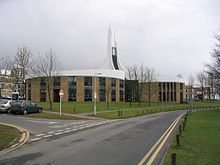Lancaster University Chaplaincy Centre

Lancaster University Chaplaincy Centre, on the campus of Lancaster University in the United Kingdom is a unique building bringing together the many faith groups represented on the campus and in the wider community. Built in 1969, it consists of three circular lobes with a three pronged spire which is the basis of the University's modern logo, introduced in its silver Jubilee year in 1989. Two of the lobes contain Christian chapels: one Roman Catholic, and one Anglican and Free Church. The third lobe is the largest and is split on two levels. On the ground floor it contains a social space (the Central Lounge), the Jewish Rooms (Synagogue, Jewish Lounge and Kosher Kitchen), and the Quiet Room (used for worship by the Quakers and meetings by the Bahá'ís amoung others). It also contains the Free Church Chaplains' office, Secretary's office and a Cafe. The upstairs contains a smaller social area, two flats (one each for the Catholic and Anglican chaplains), and a Buddhist meditation room as well as a small 'natural health' office used by a number of 'alternative' and 'complamentary' therapists and the office of 'Friends International'.

Religious student societies including the Catholic society, Jewish Society, Bahá'í Society, Christian Fellowship and Chinease Christian Fellowship meet in the centre. The Islamic society are also prominent on campus and meet in the Islamic Prayer room located on the perimiter road near Info lab 21. The centre is also used by non-religious groups including Pulsar (the science fiction society), and the LU Gospel Choir. The chapels, meditation room and Synagogue are always open and available for private prayer and meditation.
Similar facilities exist at the universities of Dundee and Bath. However, very few universities in the United Kingdom have such purpose built facilities. Lancaster was the first such joint centre in the United Kingdom.
External links
- [http: www.chaplancs.org.uk Lancaster University Chaplaincy centre website]
